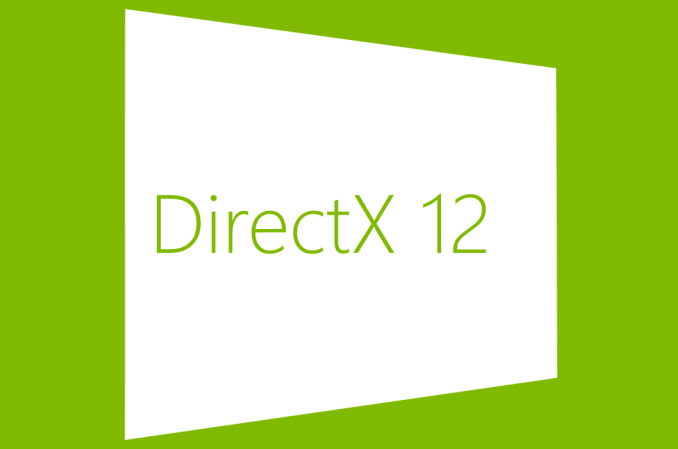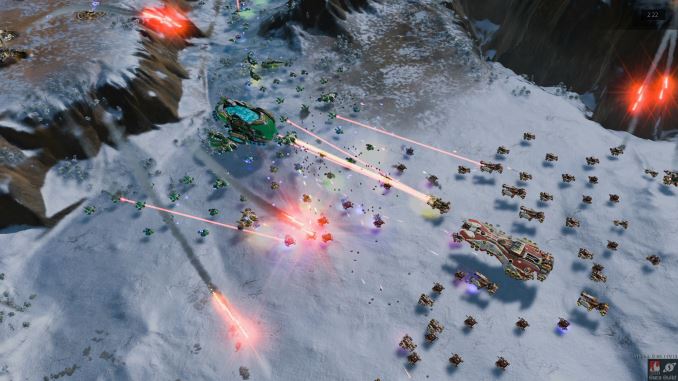Ashes of the Singularity Revisited: A Beta Look at DirectX 12 & Asynchronous Shading
by Daniel Williams & Ryan Smith on February 24, 2016 1:00 PM EST
We’ve been following DirectX 12 for about 2 years now, watching Microsoft’s next-generation low-level graphics API go from an internal development project to a public release. Though harder to use than earlier high-level APIs like DirectX 11, DirectX 12 gives developers more control than ever before, and for those who can tame it, they can unlock performance and develop rendering techniques simply not possible with earlier APIs. Coupled with the CPU bottlenecks of DirectX 11 coming into full view as single-threaded performance increases have slowed and CPUs have increased their core counts instead, and DirectX 12 could not have come at a better time.
Although DirectX 12 was finalized and launched alongside Windows 10 last summer, we’ve continued to keep an eye on the API as the first games are developed against it. As developers need the tools before they can release games, there’s an expected lag period between the launch of Windows 10 and when games using the API are ready for release, and we are finally nearing the end of that lag period. Consequently we’re now getting a better and clearer picture of what to expect with games utilizing DirectX 12 as those games approach their launch.
There are a few games vying for the title of the first major DirectX 12 game, but at this point I think it’s safe to say that the first high profile game to be released will be Ashes of the Singularity. This is due to the fact that the developer, Oxide, has specifically crafted an engine and a game meant to exploit the abilities of the API – large numbers of draw calls, asynchronous compute/shading, and explicit multi-GPU – putting it a step beyond adding DX12 rendering paths to games that were originally designed for DX11. As a result, both the GPU vendors and Microsoft itself have used Ashes and earlier builds of its Nitrous engine to demonstrate the capabilities of the API, and this is something we’ve looked at with both Ashes and the Star Swarm technical demo.
Much like a number of other games these days, Ashes of the Singularity for its part has been in a public beta via Steam early access, while its full, golden release on March 22nd is fast approaching. To that end Oxide and publisher Stardock are gearing up to release the second major beta of the game, and the last beta before the game goes gold. At the same time they’ve invited the press to take a look at the beta and its updated benchmark ahead of tomorrow’s early access release, so today we’ll be taking a second and more comprehensive look at the game.
The first time we poked at Ashes was to investigate an early alpha of the game’s explicit multi-GPU functionality. Though only in a limited form at the time, Oxide demonstrated that they had a basic implementation of DX12 multi-GPU up and running, allowing us to not only pair up similar video cards, but dissimilar cards from opposing vendors, making a combined GeForce + Radeon setup a reality. This early version of Ashes showed a lot of promise for DX12 multi-GPU, and after some additional development it is now finally being released to the public as part of this week’s beta.
Since that release Oxide has also been at work both cleaning up the code to prepare it for release, and implementing even more DX12 functionality. The latest beta adds greatly improved support another one of DX12’s powerhouse features: asynchronous shading/computing. By taking advantage of DX12’s lower-level access, games and applications can directly interface with the various execution queues on a GPU, scheduling work on each queue and having it executed independently. Async shading is another one of DX12’s optimization features, allowing for certain tasks to be completed in less time (lower throughput latency) and/or to better utilize all of a GPU’s massive arrays of shader ALUs.
Between its new functionality, updated graphical effects, and a significant amount of optimization work since the last beta, the latest beta for Ashes gives us quite a bit to take a look at today, so let’s get started.












153 Comments
View All Comments
TheJian - Sunday, March 6, 2016 - link
The highlight here isn't dx12, but rather how badly AMD is doing DX11, which is what most games will run on for quite some time to come (only 10% run win10, and much of that base doesn't have a card that can run this game at even 1080P at 30fps). A decent sized group of win10 users go back to win7 also...LOL. I'm more interested in Vulkan, now that it's out, I think it will take over dx12 after a year as it runs everywhere but consoles and they are a totally different animal anyway.This just goes to show what happens when you can't afford to support your products. IE, AMD constantly losing money quarter after quarter while R&D drops too. NV on the other hand, has the cash to massively improve dx11 (which is 90% of the market, more if you consider not everyone running win10 is even a gamer), while also making a dx12 driver. AMD clearly needs to devote more money to their current card users (dx11), but can't afford to. AMD is spending their money on the wrong things time and time again. You can blame consoles for this last 5yrs of losses, as that money should have went into making ZEN 4yrs ago, much faster DX11 support, mobile chips should be on rev 5-6 etc like NV and everyone else etc etc. We would not be looking at NV owning 82%+ of the gpu market right now, and Intel would have had a major competition problem for the last 4-5 yrs instead of basically being able to pour all their resources into mobile while beating AMD to death on cpu.
EugenM - Tuesday, June 7, 2016 - link
I cannot speak of AMD CPUs, but AMD gpus are doing very well on DX11 games, its not the DX11 implementation of AMD that is at fault for performance issues, rather than Nvidia sabotaging time and time again their games, every game which is labeled Nvidia has a potential to sabotage the entire AMD lineup and AMD has little to nothing to do about it, this is not a tin foil conspirancy theory, its a fact proven game after game after game and easelly found on google, try searching for batman games and other epic unreal engine games, try searching for crysis 2 and nvidia gameworks games, youll see what i mean. If youre a small company you cannot really do much about a big monopoly like Nvidia and Intel youre 1 fighting vs 2. Dirty tactics against AMD and even illegal tactics have also been applied by Intel vs AMD, thats why Intel was fined with a huge ammount of money but in the end the damage to AMD was already done and it was too late for AMD to recover properly. You need to realise not everything is so simple.jacksonjacksona - Thursday, March 17, 2016 - link
( www).(ajkobeshoes).(com )christian louboutin
jordan shoes $60-
handbag
AF tank woman
puma slipper woman
=====
( www).(ajkobeshoes).(com )
hhhhhhhh
hhhhhhhh